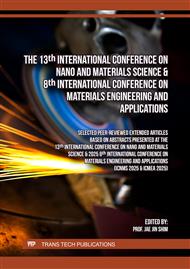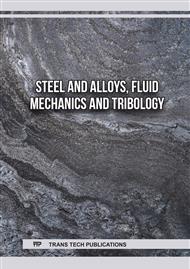[1]
Y. Burhanuddin, S. Harun, G. A. Ibrahim, and A. Hamni: Optimization of tool wear and surface roughness in ST-37 steel turning process with varying tool angles and machining parameters. J. POLIMESIN. Vol. 22 (2024), p.315–318.
DOI: 10.30811/jpl.v22i3.4983
Google Scholar
[2]
M. D. Pham, M. D. Dai, L. H. Giang, and X. Sun: Modeling and optimizing the effects of insert angles on hard turning performance. Mathematical Problems in Engineering. Vol. 2021(2021), p.1–18.
DOI: 10.1155/2021/9924427
Google Scholar
[3]
M. Mustafa, S. Pervaiz, and I. Deiab: The Effect of Rake Angle and Cutting Edge Radius on the Orthogonal Cutting Process of Ti6Al4V Alloy. Recent Progress in Materials. Vol. 6 (2024), pp.1-15.
DOI: 10.21926/rpm.2402013
Google Scholar
[4]
R. Patidar and S. Sharma: Effect of Rake Angles on Tool During Orthogonal Metal Cutting Process For Different Materials Through Ansys. International Journal of Engineering Trends and Technology (IJETT). Vol. 44 (2017), pp.141-145.
DOI: 10.14445/22315381/ijett-v44p229
Google Scholar
[5]
D. Devarajaiah and C. Muthumari: Evaluation of power consumption and MRR in WEDM of Ti–6Al–4V alloy and its simultaneous optimization for sustainable production. Journal of the Brazilian Society of Mechanical Sciences and Engineering. Vol. 40 (2018), pp.1-18.
DOI: 10.1007/s40430-018-1318-y
Google Scholar
[6]
W. L. Chu, M. J. Xie, L. W. Wu, Y. -S. Guo and H. -T. Yau: The Optimization of Lathe Cutting Parameters Using a Hybrid Taguchi-Genetic Algorithm. in IEEE Access. Vol. 8 (2020), pp.169576-169584.
DOI: 10.1109/access.2020.3022648
Google Scholar
[7]
R. M. Noor, M. I. Ramli, A. F. Zubair, A. R. Hemdi, and P. Kataraki: Optimization of cutting parameters to improve power consumption and material removal rate in high efficiency milling. Journal of Mines, Metals & Fuels. Vol. 69 (2022), p.163–169.
DOI: 10.18311/jmmf/2021/30149
Google Scholar
[8]
G. R. Chate., M. P. G. C., H. H. M., S. U. Urankar, S. A. Sanadi, A. P. Jadhav, S. Hiremath, and A. S. Deshpande: Sustainable machining: Modelling and optimization using Taguchi, MOORA and DEAR methods. Materials Today: Proceedings. Vol. 46 (2021), pp.8941-8947.
DOI: 10.1016/j.matpr.2021.05.365
Google Scholar
[9]
H. Akkuş: Multiple Optimization Analysis of MRR, Surface Roughness, Sound Intensity, Energy Consumption, and Vibration Values in Machinability of TC4 Titanium Alloy. Surface Review and Letters. Vol. 28 (2021), pp.2150072-2150077.
DOI: 10.1142/s0218625x21500724
Google Scholar
[10]
K. S. Bennett, J. M. DePaiva, E. Lazar, and S. C. Veldhuis: Leveraging metaheuristic algorithms with improved hybrid prediction model framework for enhancing surface roughness optimization in CNC turning AISI 316. Int. J. Adv. Manuf. Technol. Vol. 135 (2024), pp.1-29.
DOI: 10.1007/s00170-024-14654-w
Google Scholar
[11]
V. M. Hung, V. T. Do, P. T. M. Hue, T. H. N. Thai, and Q. M. Nguyen: Multi-objective Optimization for Enhanced Material Removal Rate and Reduced Machining Roughness in Hard Turning of SKD61 Alloy Steel. Mathematical Modelling of Engineering Problems. Vol. 11(2024), pp.680-688.
DOI: 10.18280/mmep.110312
Google Scholar
[12]
M. Q. Ibraheem: Optimization of Cutting Parameters in Milling Process Using Genetic Algorithm and ANOVA. Engineering and Technology Journal. Vol. 38 (2020), pp.1489-1503.
DOI: 10.30684/etj.v38i10a.1124
Google Scholar
[13]
T. M. El Hossainy, Y. Zeyada, and A. Abdelkawy: Machining process parameters optimization using soft computing technique. J. Eng. Appl. Sci. Vol. 70 (2023), pp.1-13.
DOI: 10.1186/s44147-023-00174-z
Google Scholar
[14]
C. Camposeco-Negrete, J. de Dios Calderón Nájera, and J. C. Miranda-Valenzuela: Optimization of cutting parameters to minimize energy consumption during turning of AISI 1018 steel at constant material removal rate using robust design. Int. J. Adv. Manuf. Technol. Vol. 83 (2016), p.1341–1347.
DOI: 10.1007/s00170-015-7679-9
Google Scholar
[15]
M. Soori and M. Asmael: A Review of the Recent Development in Machining Parameter Optimization. Jordan Journal of Mechanical and Industrial Engineering. Vol. 16 (2022), pp.205-223.
Google Scholar
[16]
L. Zhou, J. Li, F. Li, X. Xu, L. Wang, G. Wang, and L. Kong: An improved cutting power model of machine tools in milling process. Int. J. Adv. Manuf. Technol., Vol. 91 (2017), p.2383–2400.
DOI: 10.1007/s00170-016-9929-x
Google Scholar
[17]
Ü. A. Usca, S. Şap, M. Uzun, M. Kuntoğlu, E. Salur, A. Karabiber, D. Y. Pimenov, K. Giasin, and S. Wojciechowski: Estimation, optimization and analysis based investigation of the energy consumption in machinability of ceramic-based metal matrix composite materials. Journal of Materials Research and Technology. Vol. 17 (2022), p.2987–2998.
DOI: 10.1016/j.jmrt.2022.02.055
Google Scholar
[18]
A. A. A. Alduroobi, M. Q. Ibraheem, and N. H. Obaeed: Predict the Best Variants of Cutting in Turning Process Using Genetic Algorithm Technique. in 2018 2nd International Conference for Engineering, Technology and Sciences of Al-Kitab (ICETS). Karkuk, Iraq, (2018), pp.33-38.
DOI: 10.1109/icets.2018.8724617
Google Scholar
[19]
M. A. Sahali, I. Belaidi, and R. Serra: New approach for robust multi-objective optimization of turning parameters using probabilistic genetic algorithm. .Vol. 83 (2015), pp.1265-1279.
DOI: 10.1007/s00170-015-7526-z
Google Scholar



